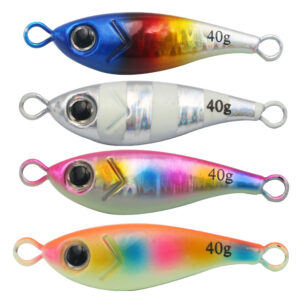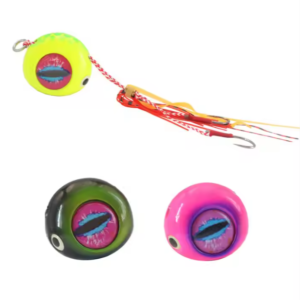Metal Jig Jigging Lure Spoon Bait with Feather New Casting Hook Lead
Fishing enthusiasts know that the right lure can make all the difference when it comes to landing that prized catch. Among the various types of fishing lures, metal jigs have gained immense popularity for their versatility and effectiveness in attracting a wide range of fish species. In this article, we’ll explore what metal jig lures are, how to use them effectively, and tips to maximize your fishing success.
Informations complémentaires
| Couleur | optional |
|---|---|
| Material | Lead, metal |
| Weight | 60g,80g,100g,120g,160g,250g,300g,350g,400g |
| Model | TX-07 |
Product Details:
Certainly! Let’s delve deeper into various aspects of using lead fishing lures, expanding on specialized techniques, target species strategies, and additional considerations for success on the water.
Specialized Techniques for Different Species
Each fish species has unique feeding patterns and behaviors, and adapting your lead lure techniques to these can yield great results.
1. Bass Fishing
- Football Jigs: Use football-shaped lead jigs that are excellent for flipping and dragging across rocky bottoms. Combine with a trailer to enhance the presentation.
- Shaky Head Rig: A lead jig head with a soft plastic worm offers a finesse approach, ideal for pressured bass in clear water. The slow wobble can be irresistible.
2. Pike and Muskellunge
- Heavy Spinnerbaits: Using lead in the design of heavy spinnerbaits can help penetrate through weeds and provoke aggressive strikes. Look for combinations that allow for high visibility and noise.
- Trailing Live Bait: Pair lead weights with live suckers or chubs, letting the bait swim freely. This tactic is especially effective during the warmer months when pike are hunting actively.
3. Trout Fishing
- Weighted Nymphs: For fly-fishing, incorporate lead into nymph patterns to help them reach the bottom quickly, mimicking natural prey. This is particularly effective in fast-flowing streams.
- Trolling with Spoons: Use lead-weighted spoons that dive at specific depths while trolling; adjust your speed based on water temperature and trout activity.
4. Walleye Fishing
- Bottom Bouncers: These rigs use lead weights to help keep the bait near the bottom where walleyes often feed in sandy or rocky areas. This presentation is particularly effective during low light conditions.
- Live Bait Rigs: Incorporate lead weights at the bottom of a rig with a hook exposed for nightcrawlers or leeches, allowing for a natural presentation.
Season-Specific Strategies
Tailoring your approach according to the season can significantly influence your success with lead lures.
Spring
- Fish are actively feeding as they prepare for spawning. Use bright colors and erratic retrieve styles to provoke aggressive bites.
- Concentrate on shallow waters, especially near spawning grounds. Weight your rigs to keep your lures near the bottom.
Summer
- As temperatures rise, fish often retreat to deeper, cooler waters. Use heavy lead lures to fish at these depths, particularly during the hottest parts of the day.
- Night fishing can be particularly fruitful; consider glow-in-the-dark lures or those with reflective finishes to attract fish in low light conditions.
Fall
- Fish are on a feeding spree to prepare for winter. Use larger lures and experiment with size and color patterns, mimicking the larger baitfish.
- Target coves and sheltered areas where fish gather before moving to deeper waters.
Winter
- Ice fishing presents unique opportunities. Use lead jigs or spoons that can be vertically dropped through holes. Adding scent can help attract fish.
- Keep your presentation subtle and slow, as fish tend to be lethargic in colder temperatures.
Environmental Impact and Sustainability
Given the implications of using lead in fishing, a commitment to sustainable practices is vital.
1. Using Lead-Free Alternatives
- Many manufacturers now offer fishing lures made from tungsten, steel, or biodegradable materials that replicate the benefits of lead while minimizing environmental risks.
2. Educating Others
- Share insights with fellow anglers about the dangers of lead and encourage them to adopt lead-free alternatives. Community awareness can drive more significant changes in local fishing practices.
3. Monitoring Local Regulations
- Stay updated on changes regarding lead use in your area, as many regions are moving towards banning or regulating lead in fishing tackle. Follow local wildlife management practices to support conservation.
Maintenance and Care for Lead Lures
Proper care and maintenance enhance the lifespan and performance of your lead lures.
1. Regular Inspection
- Check your lead lures for wear and tear, including rust or chips in the finish. These can affect how effectively they attract fish.
2. Storage Practices
- Store your lures in a tackle box that prevents them from scraping against each other, which can cause damage to hooks or finishes. Consider using moisture-absorbing packets in your tackle box to prevent rust.
3. Cleanliness
- Wash lures after every trip to remove dirt, slime, and scents from previous catches. This can minimize fish-spooking odors.
Engaging with Technology
Using technology can significantly improve your fishing practices:
1. Fish Finders
- Invest in a quality fish finder. This can help you understand water depths, temperature changes, and locate fish holding structures. By knowing where the fish are, you can adjust your lead lures accordingly.
2. Smartphone Apps
- Utilize fishing apps that offer weather forecasts, tide schedules, and fishing reports specific to your area. These tools will help you optimize your fishing times and locations.
Conclusion
Mastering the art of using lead fishing lures involves understanding the nuances of each technique, adapting to seasonal changes, and exercising sustainable fishing practices. By exploring specialized approaches for different fish species, refining your strategies throughout the seasons, and engaging in community conservation efforts, you can enhance your experience on the water while preserving the environment. Always remember that education and adaptation in fishing not only lead to better catches but also contribute to the sustainability of our waters. Happy fishing, and may you enjoy every moment on your next fishing adventure!
Produits similaires
-

New Metal Jig Luminous stick bait lure deep sea fast sinking lures lead fishing bait metal jig fishing lures
-

New Casting Metal Jigging Lures 3d Eyes Tungsten Deep Sea Jig Isca Slow Pitch Jigs Fast Sinking Decoy
-

Flat-Side Jigs Fishing Metal Jig Lure Saltwater Lure Fish Lure Tuna Shore Jig For Sale 60-400G
-

Fishing Running Sliding Replace Jigs Saltwater Fishing Lure Madai Jig






